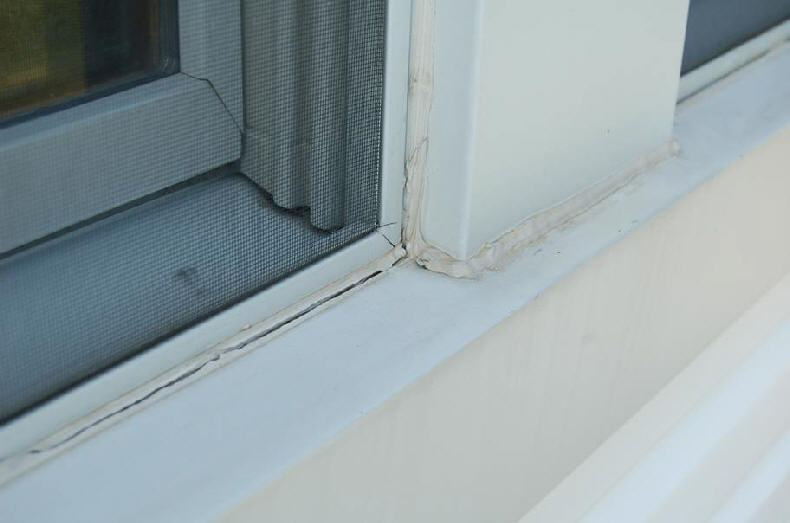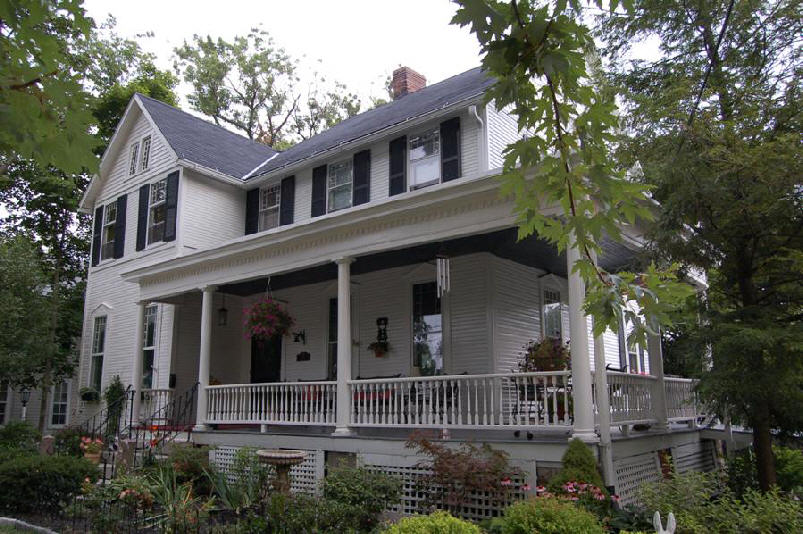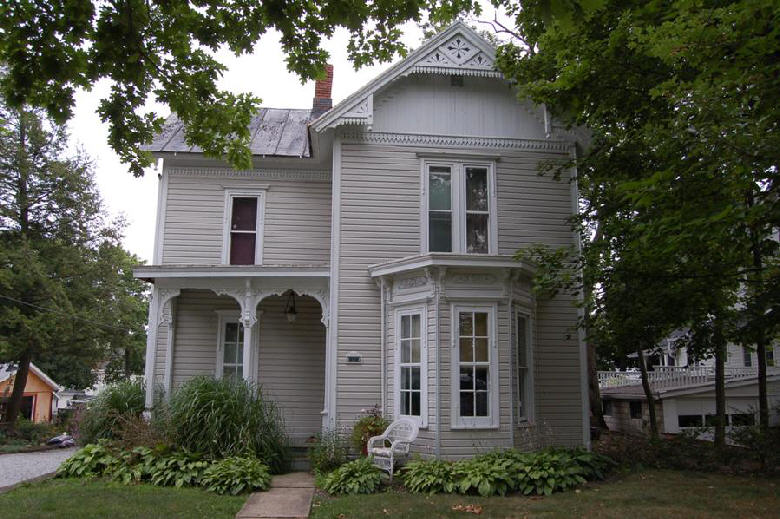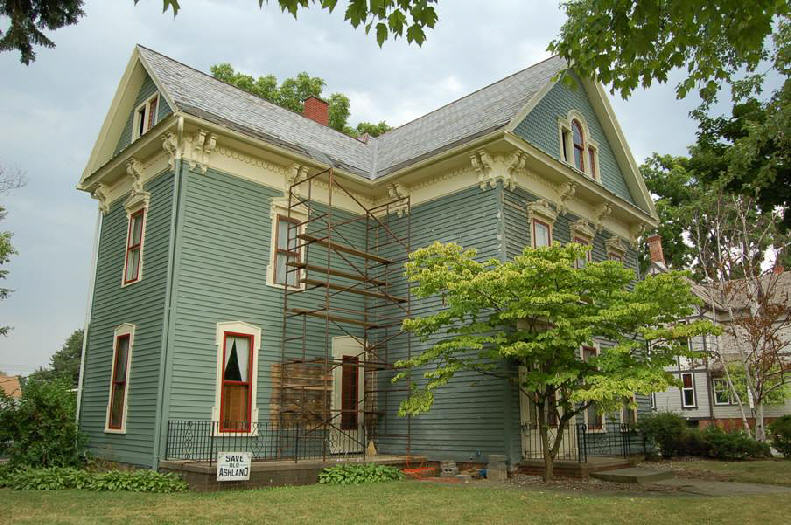Since the enactment of the National Historic Preservation Act in 1966, the concept of historic preservation has made remarkable advances in America. Visiting the cities and neighborhoods where it has taken hold is a rich, rewarding experience, and our country’s cultural heritage has been forever enhanced. Unfortunately, for many smaller towns and less affluent neighborhoods in America, many of which have in recent decades been faced with profound economic challenges, the idea that our old buildings are important and worth investing in, is only very, very slowly trickling down. In the meantime, America’s old neighborhoods are being stripped of their historic character, one house at a time, at an alarming rate due to the proliferation of “home improvement” contractors. These types of contractors, the number of which have increased threefold in the last ten years, are contractors who specialize in quick installations of high profit materials. The products they push the hardest are vinyl siding and replacement windows, and their involvement with old houses and historic neighborhoods is often devastating.

The old house at left has been vinyl sided and entirely stripped of its historic detail and character. Compare it to its neighbor whose owners have retained its original siding and details, and accentuated them with a three color paint scheme. Note that this house has no fantastic architectural features, just many common period details. It’s their collective effect, however, that give the house its historic charm. Unfortunately, in many towns and neighborhoods in America, well cared for houses like this are becoming rare, while stripped-down, vinyl boxes like the one at left are becoming the norm.
I’m not writing here about the old practice of ripping off architectural components to make the vinyl siding process easier. I’m assuming that anyone taking the time to read this probably values their historic house, and would communicate to their contractor that removal of trim features is unacceptable. Be aware though, that home improvement contractors generally don’t like dealing with old wood trim because it slows them down, making the job less profitable. They would much rather pry, saw, or hack it off, usually telling the homeowners that the trim is rotten and “can’t be saved”. I wish I could say that this was only true among the worst cases, but I still see it happening all the time.

A “home improvement expert” preparing a house for vinyl siding by tearing off the ornamental wood window tops. This picture wasn’t taken in the 1950’s, but in 2004., and the house he’s working on/over sits in a district listed on the National Register of Historic Places. Unfortunately though, in this instance there is no local protective legislation prohibiting vinyl siding.
|
As an owner of a vintage home you should avoid covering it with vinyl and/or aluminum siding for three main reasons, and they’re very important reasons. First, from a practical standpoint, it can be unhealthy for your house, and second, from an aesthetic standpoint, it undermines the visual properties that attracted you to your old house in the first place. Lastly, the “maintenance free” promise of vinyl siding is simply not true.
From a practical standpoint, vinyl siding eliminates a wood frame house’s ability to tell you when something’s gone wrong. When unwanted water finds its way into the walls of an old house, through roof leaks, poor interior ventilation conditions, or any other source, there will be a concentrated area of peeling paint which appears on the outside of the house. As long as the source of moisture is identified and eliminated promptly, the wood will dry out quickly, and can generally be repainted before serious deterioration occurs. When the house is covered with vinyl or aluminum, materials that are unaffected by water, the warning signs are concealed and the deterioration continues unnoticed within the walls. Because the house’s exterior has been officially declared “no maintenance”, nobody’s looking too closely.
|

This view shows the corner of the porch of a recently sided circa 1900 Queen Anne style house. Every surface, with the exception of the original columns, has been covered with aluminum or vinyl. If there’s ever any water damage occurring inside these boxes, it will be a long, long time before the owner knows about it.
|
As part of the vinyl siding process, some of the home’s elements, most often window surrounds, are wrapped in what is known as “break metal”. It’s called this because the contractor uses a big tool called a “break” to bend aluminum into box shapes. These site fabricated pieces of aluminum are then used to cover up any original wood pieces that can’t be covered up with vinyl siding. Vinyl siding can only be used over the flat areas of the house. Using break metal as part of the process is a way of getting a highly standardized product, like a vinyl siding system, to work on a non-standardized background, like a well crafted old house. The problems arise at the joints where the pieces of break metal meet. This is where the contractor uses a quickly applied bead of caulk to form a seal to keep water out. Home improvement contractors love caulk and use it freely as a quick and easy substitute for properly dealing with how materials come together. The problem is that the bond between the caulk and the break metal can quickly open up, often soon after the siding job is completed, allowing water to enter the wall cavity. The vinyl siding then prevents the underlying original wood trim and structure from drying out, and the deterioration continues unnoticed due to the water-impervious nature of the vinyl covering. Once again -out of sight, out of mind.

This photo shows how the vertical and horizontal pieces of brake metal meet on a recently sided over 1885 Victorian. Note the sloppy caulk joint, which is the only thing keeping water out of the original window sill beneath. Notice also how the caulk joint at left has already opened up completely. Should we wonder where all that rain water is going?
This old house, shown during its “improvement” by vinyl siding, illustrates the tragic, but still all too common, details of the process. The projecting window tops and horizontal decorative moldings have been torn off, the window surrounds have been covered by break metal, and the vinyl corner pieces and J-channel have been nailed on in preparation for the imitation siding.
|
Other physical problems which come up when installing vinyl siding over old houses are the “creative” use of J-channel and the need to nail through the original siding. Vinyl siding contractors use a standard “accessory” piece known as “J-channel” at places where the horizontal siding meets a vertical element. The long, rear leg of the J shape is nailed to the house, and then the siding pieces are slipped in. The front, short leg of the J shape conceals the end of the siding. The J-channel is necessary because vinyl expands and contracts with outside temperature variations far more than wood, and without it, gaps would open up at all these joints.
|
If a homeowner insists on saving their original trim, the contractor will install J-channel around it. Getting the J-channel to fit around anything but the plainest and straightest trim usually results in a great deal of clipping, patching and scabbing, adding to the ugliness of the whole affair. Since the new siding is usually applied over top of the original siding, the projecting moldings, window casings, etc, look half submerged in the new vinyl siding.
|
A good example of the “creative” use of J-channel. Note the frantic clipping required to get the J channel to conform to the irregular and curved outlines of the original woodwork, and the way that the window and pilaster at right seem to be nearly submerged in the vinyl siding. Even if you can live with this look, how weatherproof do you think this kind of detailing really is?
|
The only real benefit of vinyl siding is that it’s cheap. The trouble is that it also looks cheap. This brings us to the second problem with vinyl siding on old houses.
When viewed from any closer than the curbside, vinyl siding has a flimsy, sterile look. In reality though, we don’t just experience our houses from the curbside. We experience our homes up close, every day, and we enjoy the details that make them special, and very different from new houses. It’s hard to put your finger on what attracts some of us emotionally to an old house, but too many old house owners find out too late that their decision to vinyl side has unwittingly destroyed a big part of what attracts them to their old house. Visit a historic district that does not allow fake siding and you’ll quickly understand the difference it makes. Then go take a good, close look at houses that have already suffered the installation of vinyl siding. The more you look, the clearer it is that visually, it makes an incredibly big difference.
The first impulse of people new to restoration and old house living is often to attempt to turn back the hands of time in order to achieve a state of perfection that, if it ever existed at all, was probably very short lived. Old houses are made of real, natural materials, and, like their owners, they age. People who appreciate and understand old houses, however, develop an often hard to describe attraction and attachment to these signs of vulnerability. Among the words old house owners commonly use to describe this feeling are patina, character, charm, and ambiance. But one word that is seldom used to describe their old house, or their restoration efforts, is perfection. In addition to the special connected feeling they give us, a big part of the attraction of old houses is their appearance and sense of age. If we want perfection, there are thousands of new home developments trying hard to create the illusion.
|

This historic house, it's simple architectural details lovingly maintained by its owner, is located in a neighborhood gradually being stripped of its historic character by siding contractors. One can only imagine the quality of the streetscape if more people valued the special charm of these homes.
|
In his book, Creating a New Old House, Russell Versaci does a wonderful job of characterizing the houses being built today. In the chapter titled “The Faux Traditional House: A House Meant for Curb Appeal, he states: “Many of today’s homebuilders seem to have lost touch with the principles of the old way of building. Keenly aware of the attraction of old architectural styles, the faux traditional house has become universal in subdivisions across the country. These are houses built with a veneer of history painted onto the surface like wallpaper. Contemporary home builders on tight timetables tend to shun the old way of building because it requires a commitment to craft and quality. When we see a faux traditional home, most of us recognize instinctively that something about the house is wrong. The mass-produced decorative details look tentative and impermanent. We recognize that they are houses built for expediency and not for beauty, and they were never meant to last”.We’ve all experienced the houses he’s talking about. The wood siding is fake, the brick is only a veneer (and it’s only on the front of the house), the doors look like wood, but they’re plastic too. It is this stage set quality that pervades new houses that most people who have lived in and enjoyed old houses find so unsettling and disappointing.
If you want to see real world evidence of people’s deep, instinctive need and reverence for the authentic sense of place experienced with old houses, take a close look at the settings of TV commercials, sitcoms, movies, etc. It’s amazing – you’ll notice that nearly all of them take place in beautiful old houses, apartments or office buildings. They almost never take place in newer architectural settings. Subconsciously, the people we identify with, and find the most interesting, live and work in comforting old places full of meaningful details and authentic historic character. If you’re one of the small percentage of people who actually do inhabit such a place, value it and protect it for generations to come!
|
Is it really reasonable to believe someone who is telling you that covering up 75, 90, or even 100 percent of your historic home’s exterior with a modern synthetic material is a good thing, and that it won’t make much of a difference in the house’s appearance?
|
And finally, in spite of what the manufacturers and installers will tell you, vinyl siding is not maintenance free. The vinyl siding sales guys will tell you that “It will never need painted….”, but they never tell you the second part of the sentence which is “…if, after one to ten years, you’re willing to live with a dull, washed out looking house”. Old houses often look their best when painted rich colors, and it’s a near universal truth, whether you’re talking about paint, siding, or anything else, that the darker the color, the quicker it will fade. Another real problem is that if the siding is ever damaged it will be virtually impossible to color match the repair because the siding begins to gradually fade as soon as it's installed. The only way to handle this is to repair the vinyl (if your pattern is still available) and then, (guess what!) paint the siding so that it all matches. Ask the guys at your local paint store – paint for faded vinyl is something they’re selling a lot of. Additionally, if you’re after the lowest bid to get your vinyl siding on, you’ll probably be out in your yard picking up strips of vinyl after a storm sooner than you might think.
Sometimes a historic home owner will insist that their contractor not remove any detail and that they cover up only the siding. Any painter or homeowner who’s ever painted their own house will tell you that the siding is the easiest and quickest part of the house to paint. It’s the detailed areas that take up most of the time. So the next time they paint they don’t have to paint the siding, but now they’ve got a bunch of J-channel to carefully paint around. Color by the way, is a highly personal issue with old houses, and homes are often repainted when they change ownership. Obviously, installing vinyl permanently locks a house into a siding color, and can even limit future trim color choices.
|

It appears that the owners of this house were insistent that their contractor work around all the beautiful original detail. Only the original siding itself has been covered with vinyl siding. What percentage of the painting do you think they’ve actually gotten rid of? And how satisfying will it be to finish a future paint job and see the newly painted detail work set off against the slowly fading vinyl siding?
|
The truth is that if a person’s primary objective is an escape from the need to do, or pay for, any maintenance work, they should not be living in an old house. New home subdivisions and condominium developments are much better places to look for shelter housing than any old house.
Instead of resorting to covering up their houses historic materials, old house owners should plan a reasonable amount of time and cash into their budgets, and stay current with the technologies that are quickly evolving to make maintaining an old house more manageable. A great deal of the time involved in painting a house goes into the prep work – scraping peeling paint, caulking, sanding and priming the bare spots. By painting on a regular basis, before the peeling becomes widespread, the amount of time required for a paint job can be drastically reduced.
Paint manufacturers, I believe due to increasing competition from siding manufacturers, are actively striving for more durable paints. Let’s face it, it’s not in their best interest to continue to allow houses to be covered over with vinyl. All the paint companies now offer premium house paints formulated for increased durability, and if a historic home owner is investing the time and/or money for thorough prep work, they can be worth the money.
|

This house is in the process of having its paint stripped by the homeowners, one small section at a time, using an infrared stripping tool to help remove over 100 years of built up paint. The owners have needed to replace only a small amount of wood siding, and the repairs are virtually undetectable.
|
Paint removal, done without damaging the house’s original woodwork, is a slow process, but it's well within the skill range of the patient and attentive homeowner. Removal of excessive paint build-up, aside from moisture control, is the single most important factor affecting paint duration.
|
As a historic restoration contractor and student of our architectural heritage, I’m all too aware of the profoundly destructive effect that replacement siding has had on our historic neighborhoods and individual homes. I hope that in writing this it will help convince the owners of historic homes to spend their money on planned and managed maintenance, not on petroleum products molded to look like the things that real houses used to be made of.
|
|
|
No comments:
Post a Comment